Dell Precision T1650 Workstation Review: Ivy Bridge Xeons Bring Performance
by Dustin Sklavos on July 31, 2012 12:00 AM EST- Posted in
- Systems
- Dell
- Workstation
- Ivy Bridge
- Enterprise
Workstation Performance
While the basic application performance was mostly in line with what I expected, the workstation performance of the Dell Precision T1650 is oftentimes eye-opening. SPECviewperf runs such a broad array of tests that oftentimes it can be difficult to pin down exactly what component helps where; still, it's helpful to see just how potent the new workstation is.

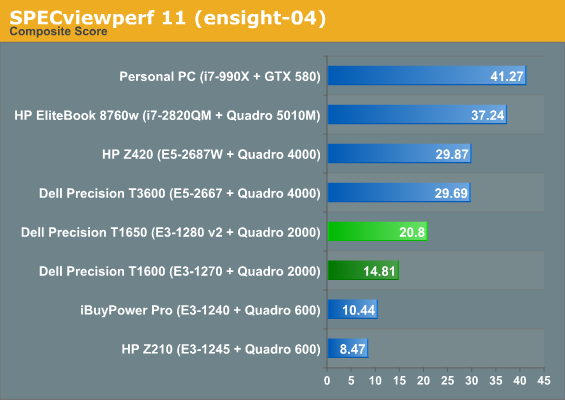
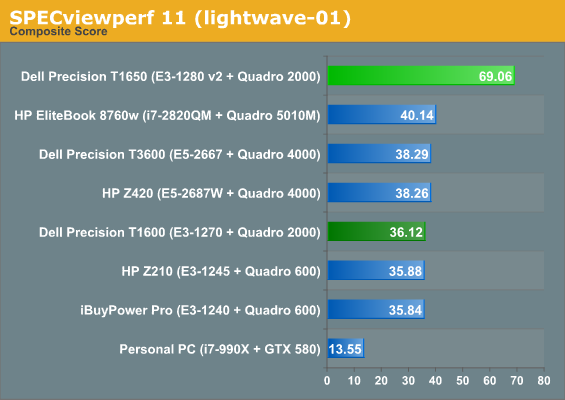

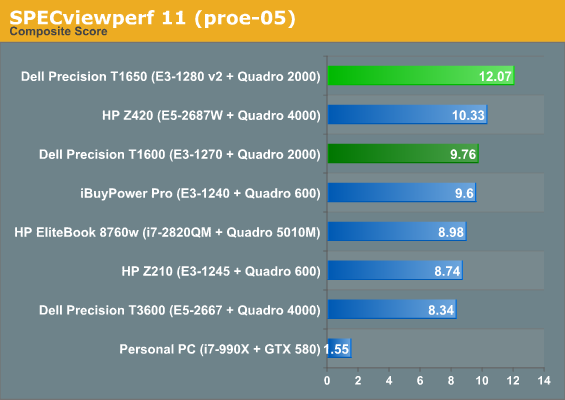
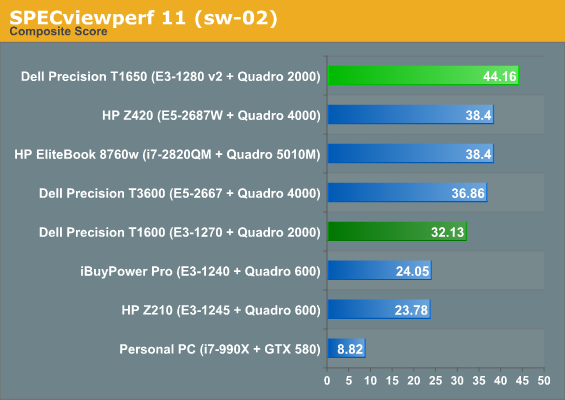
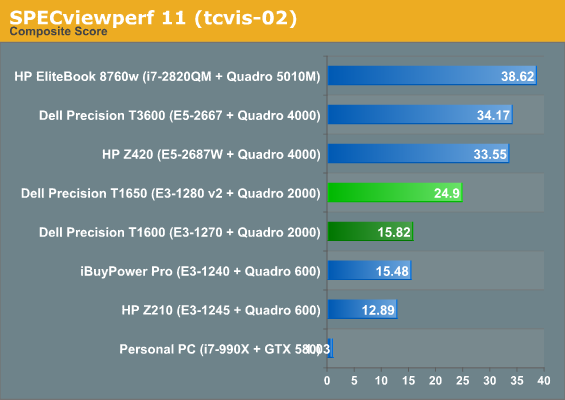
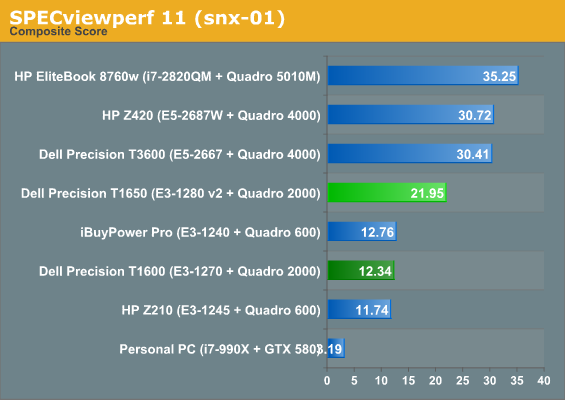
The T1650 may have had a modest boost over the T1600 in desktop applications, but jump over to SPECviewperf 11 and it's a bloodbath. There are three major differences to account for here: the T1650 has twice as much memory as the T1600 did (the T1600 had only 4GB) and that memory is running at a higher speed, the E3-1280 v2 has both higher clocks and a higher IPC, and the drivers used on the Quadro 2000 are bound to be newer. It's still difficult to figure out how the Lightwave portion, a benchmark that up until this point seemed to be moderately GPU-limited, produces a score quite so high, though.
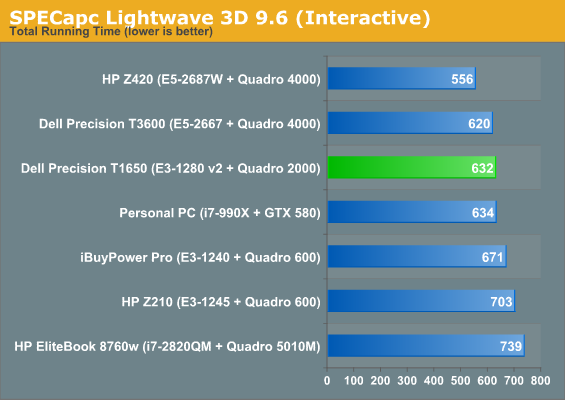
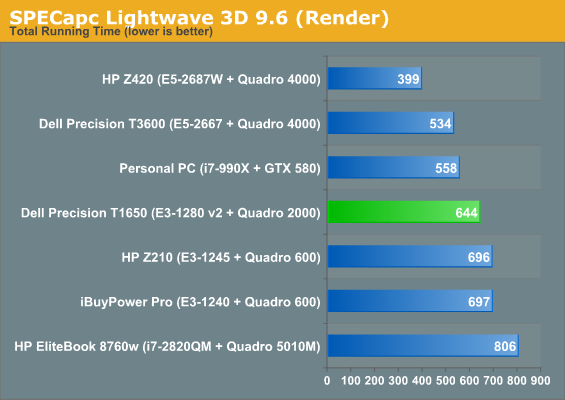

When we run the separate SPECapc Lightwave benchmark, results are a little more in line with what we expect, but it's clear the T1650's Xeon v2 is still a demon capable of meeting or beating faster hexa-core systems like the T3600.










38 Comments
View All Comments
secretmanofagent - Tuesday, July 31, 2012 - link
Perhaps I'm being naive, but why would you still include USB 2.0 ports if USB 3.0 is backwards compatible? The only thing I can think of is that they don't think four USB ports are enough, and I can maybe buy that, but it means the user has to think about which port they're going to plug into.Also, how is 8GB middle of the road for a workstation? I would think the minimum would be 16GB.
Has HP's reliability gotten any better? I've had horrible experiences with them, and our IT department isn't keen on them either.
aicom64 - Tuesday, July 31, 2012 - link
USB 3.0 is only backwards compatible at the hardware level. Without proper USB 3.0 drivers, the ports won't work at all, even in USB 2.0 mode. With Windows 8, I'd expect we'll start to see some motherboards with only USB 3.0, but for now we need some USB 2.0 ports just to get through installation to install the USB 3.0 drivers. On the Apple side, it's not a problem because the keyboard and trackpad are connected via internal USB 1.1 connection even though all external ports are USB 3.0.secretmanofagent - Tuesday, July 31, 2012 - link
Very interesting, I had no idea. Thanks for the reply.Robert Pankiw - Tuesday, July 31, 2012 - link
I know aicom64 posted a great answer, but I just enforce that with, my keyboard doesn't work at startup using USB 3.0, but on USB 2.0 it is fine, even though once I am in Windows, my keyboard works in either port. As aicom64 alluded to, issues (like that) will be solves in Windows 8.Braincruser - Tuesday, July 31, 2012 - link
In addition to that, adding 10 USB 3.0 instead of 4x 3.0 + 6x 2.0 can exhaust the internal bandwidth or will take up too much PCI-E links to operate, and on the other hand, only a few devices benefit from usb 3.0, mostly ones that are data storage and transfers like hard drives. there is no point connecting a mouse and a keyboard to a usb 3.0 when an inexpensive 2.0 will do just the same.augiem - Tuesday, July 31, 2012 - link
If your keyboard doesn't work before you get into Windows, having Windows 8 on your system won't solve anything. The Bios/UEFI would have to support it. Windows 8 preinstalled systems may have this requirement, I don't know, but certainly installing Win8 on your current PC won't help in that regard.softdrinkviking - Friday, August 3, 2012 - link
Yup. Except that I don't think any mobo companies will bother with usb 3.0 support in any bios. Bios is almost legacy, so they will probably focus on enabling it in UEFI only.IanCutress - Tuesday, July 31, 2012 - link
I would like to add, as I end up installing OSes on different Z77 motherboards every week, that sometimes the chipset USB 3.0 do work on install. I have a motherboard here now that has only USB 3.0 on the back panel, but enough of them work during a USB Win7 install to go through it until we can install the rest of the USB 3.0 drivers.Ian
bobj3832 - Tuesday, July 31, 2012 - link
USB 3 has separate transceivers for the USB 2 and 3 parts. USB2 uses 4 pins while USB3 uses 9 because it's the the 4 from USB2 plus 5 more. Another transceiver means more die space on the chip is used and more pins which increases cost.owned66 - Tuesday, July 31, 2012 - link
never ever buy from companies like thesethese desktops wont live long
the first thing that gonna die is the motherboard just look at it !